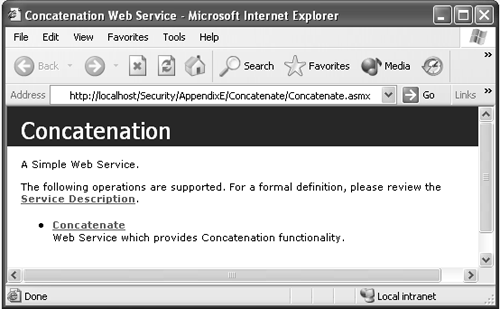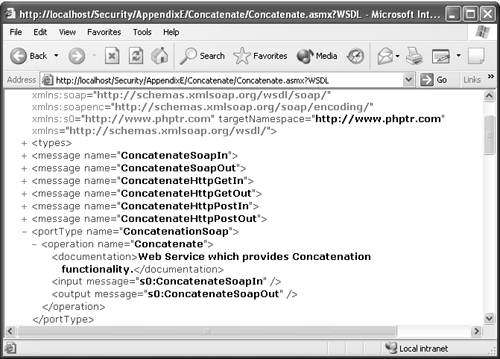Developing a Simple Concatenate Web Service
| From the File menu select New Project. The dialog box with different types of projects will be displayed, as shown in Figure E-5. Select ASP.NET Web service from the Visual C# Projects and type the location of the localhost Web server (or the name of the IIS Web server on which to host the XML Web service). After typing the location, press the OK button. Visual Studio automatically creates the necessary files and references to support a Web service. After you press OK, the IDE displays the .asmx file in Design View (since XML Web services are inherently nonvisual, you cannot drag and drop controls or other visual elements in Design View). Click the link Click here to switch to code view in the Design View to add the code to the Web service. [1]
Figure E-5. Creating a Concatenate ASP.NET Web application project. When the project is created, the Web service has the name Service1.asmx . Rename the Service1.asmx file in the Solution Explorer Concatenate.asmx . The addressable entry point for the Web service is specified by the .asmx file Concatenate.asmx . The implementation for the methods that the Web service provides is in the file Concatenate.asmx.cs . To view the .asmx file, right-click the .asmx file in the Solution Explorer and select Source Code (Text) Editor in the Open With dialog box, and then click Open, as shown in Figure E-6. Figure E-6. Open With dialog box. Use the following URL to access the program: http://localhost/Security/AppendixE/Concatenate/Concatenate.asmx . Concatenate.asmx and Concatenate.asmx.csThe code of the Concatenate.asmx file has just the following WebService directive: <%@ WebService Language="c#" Codebehind="Concatenate.asmx.cs" Class="Concatenate.Service1" %> The code of Concatenate.asmx.cs file is as follows . [View full width]
TESTING CONCATENATE WEB SERVICEEven without creating a client for your Web service, you can view and test it by employing ASP.NET. After creating the Concatenate Web service in Visual Studio .NET, just click the Run button to view the IE (Internet Explorer) test page. [2] Figure E-7 shows the IE test page, which lists all the available Web service methods. (In our example, only one, Concatenate , is available.)
Figure E-7. The Internet Explorer test page for the Concatenate Web service. Now, let us test our Web service by clicking the link Concatenate in the IE test page. Figure E-8 shows the test page that is displayed when you click the link. This test page has two sections. The first part consists of two textboxes and an Invoke button that allows you to run the Concatenate Web service method without needing to create a client. The second part consists of a list of different protocols (HTTP POST, HTTP GET, and SOAP) you can employ to connect with the Web service and a description for each message format. If you press the Invoke button, the result is displayed inside a new browser window in the XML format, as shown in Figure E-9. Figure E-8. Invoking Concatenate Web service method. Figure E-9. The result from Concatenate Web service method in XML format. SERVICE DESCRIPTIONIf you click the Service Description link, WSDL is displayed that defines the service description of that Web service, as shown in Figure E-10. A WSDL document can be logically divided into two sections:
Figure E-10. Viewing the Concatenate Service Description (WSDL document). WSDL Element: typeThis element provides the definition for the datatypes in a SOAP message. The <types> element contains an XSD schema. For example, the <types> section in the WSDL file of the concatenate Web service defines the following types:
WSDL Element: messageThe <message> section offers a description of the message. WSDL Element: portTypeThe <portType> section describes the service interfaces of the operations that the Web service supports. If there had been more Web methods in the Web service, there would have been more operation elements allied with the portType . WSDL Element: serviceThe <service> section describes the URL of the Web service on the server. WSDL Element: bindingThe <binding> section defines the data encodings and protocols to be used for each operation. Later, we discuss how to consume the developed Web service. Now, let us study in detail the WebService directive and the System.Web.Services namespace. @ WebService DirectiveTo declare a Web service, place the WebService directive at the top of a file with an .asmx extension. <%@ WebService class="Service1" Language="cs" %> The WebService directive indicates the class implementing the Web service and the programming language used in the implementation. The essential attributes of the WebService directive include the following:
If the implementation of the Web service resides in an assembly, then declare as follows: <%@ WebService Language="cs" Class="Class Name, Assembly Name" %> System.Web.Services NamespaceThe System.Web.Services namespace consists of the classes that facilitate development and use of Web services. Let us investigate the classes in System.Web.Services namespace in detail. Table E-1 shows the classes in the System.Web.Services namespace. Table E-1. Classes in System.Web.Services Namespace
WebServiceAttributeYou can use the WebServiceAttribute to add information to a Web service. It is optional. This is used in the service description and the service help page of the Web service. The attribute is not required for a Web service to be published and executed. Table E-2 shows the instance properties of the WebServiceAttribute class . Table E-2. Instance Properties of the WebServiceAttribute Class
In our first example, Concatenate.asmx , you may notice these properties in the code and in the program output as follows.
The default value of the namespace is http://tempuri.org/ for Web services that are under development, but published Web services should use a more permanent namespace. It is highly suggested that this default namespace should be personalized before the Web service is made publicly consumable. This is important because the Web service needs to be distinguished from other Web services. To apply the WebService attribute, insert the WebService attribute before the class declaration and set the Namespace and Description properties. Separate multiple properties with a comma. [View full width]
When you run the Concatenate program without the WebService attribute, you can see more details concerning the need for the WebService attribute in the test page. WebService ClassSystem.Web.Services.WebService class is an optional base class for Web services, which provides access to common ASP.NET objects such as Session, Server, Application, Context , and User . You can derive Web services directly from System.Object , but, by default, Web services created using Visual Studio .NET automatically derive from the WebService base class. If you create a Web service without deriving from the WebService class, then you cannot access the ASP.NET objects. If the Web service does not inherit from the WebService base class, it can access the ASP.NET intrinsic objects from System.Web.HttpContext.Current . Let's scrutinize the properties of the WebService class. Table E-3 shows the properties of the WebService Class. Table E-3. Properties of the WebService Class
WebMethod AttributeIf you want to expose your public method as part of the Web service, add the WebMethod attribute to that public method. The WebMethod attribute provides the following properties:
WEBMETHOD ATTRIBUTE: BUFFERRESPONSEThe BufferResponse property of the WebMethod attribute facilitates buffering of responses before they are sent to the client for a Web service method. If this property value is true, then it serializes the response of the Web service method into a memory buffer until either the response is completely serialized or the buffer is full. After the response is buffered, it is returned to the Web service client over the network. The default value is true. The buffering technique improves performance by reducing the communication between the worker process and the IIS process. If you set this property to false, ASP.NET buffers the response in 16-KB chunks . If you don't need to place the whole contents of the response in the memory, or if the Web service method returns large amounts of data to the client, then you might set this property to false. SOAP extensions are disabled for the Web service method if this property value is false. [WebMethod(BufferResponse=false)] Public string GetData() { // Implementation code } WEBMETHOD ATTRIBUTE: DESCRIPTIONYou can make use of the Description property of the WebMethod attribute to provide a name for the Web method which is to be published. It is optional. This is used in the service description and the service help page of the Web service. The default value is String.Empty . In the following example the string "Web Service which provides Concatenation functionality" is used to describe the Web service method, and the same can be used in the WSDL file, as shown in Figure E-10. [WebMethod (Description="Web Service which provides Concatenation functionality.")] public string Concatenate(string s1, string s2) { string s3="Concatenated String ="; return s3+s1+s2; } WEBMETHOD ATTRIBUTE: MESSAGENAMEThe MessageName property of the WebMethod attribute facilitates a unique name to the overloaded or polymorphic methods. The MessageName property can be used to alias method or property names . To exemplify this property, let's look at a simple add Web service that has three methods. [WebMethod (Description="Add two floats.")] public float Add(float s1, float s2) { return s1+s2; } [WebMethod (Description="Add two integers.")] public int Add(int s1, int s2) { return s1+s2; } [WebMethod (Description="Add three integers.")] public int Add (int s1, int s2, int s3) { return s1+s2+s3; } The program compiles nicely without a problem. But if you request the Web service, you come across the following errors for overload and polymorphic methods, respectively.
If you alter the program as follows, using the MessageName property, the program runs smoothly. [WebMethod(Description="Add two Floats.",MessageName="Add2Floats")] public float Add (float s1, float s2) { return s1+s2;} [WebMethod (Description="Add two integers.",MessageName="Add2Integers")] public int Add (int s1, int s2) { return s1+s2;} [WebMethod (Description="Add three integers.",MessageName="Add3Integers")] public int Add (int s1, int s2, int s3) { return s1+s2+s3;} You can see that the WSDL description names are unique now. CACHING IN ASP.NET WEB SERVICEYou can incorporate the caching behavior to an ASP.NET Web service by setting the CacheDuration property of the WebMethod attribute as follows. [WebMethod(CacheDuration=30)] The value of the CacheDuration property indicates how many seconds ASP.NET should cache the results. You should set the CacheDuration property of the WebMethod attribute to any value greater than zero. The default value of CacheDuration property is zero. TRANSACTION IN ASP.NET WEB SERVICEYou can incorporate the transaction behavior (new transaction) of an ASP.NET Web service by setting the transaction property of the WebMethod attribute as follows.
System.EnterpriseServices.dll namespace contains methods and properties that expose the distributed transaction model found in COM+ services. If an exception is thrown during the execution of the transaction process in a Web service method, the transaction is automatically aborted (using the SetAbort method of the System.EnterpriseServices.ContextUtil class). If no exception happens, then the transaction is automatically committed (using the SetComplete method of the System.EnterpriseServices.ContextUtil class). The TransactionOption property of the WebMethod attribute specifies how a Web service method participates in a transaction. Table E-4 shows TransactionOption enumeration members . Table E-4. TransactionOption Enumeration Members
The TransactionOption property can be set to any of the TransactionOption enumeration values. But the TransactionOption enumeration of a Web service method has only two possible behaviors.
The default value is TransactionOption.Disabled . Session ManagementThe EnableSession property of the WebMethod attribute facilitates session state for a Web service method. The basic steps are as follows:
You can access the stored information in the Session object if you set this property to true. [WebMethod(EnableSession=true)] public String SessionCount() { // Code } |
EAN: 2147483647
Pages: 126





